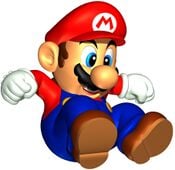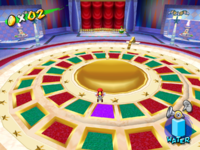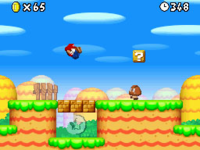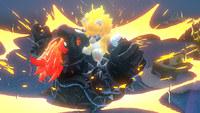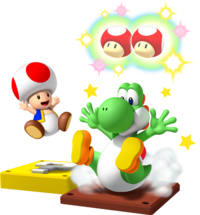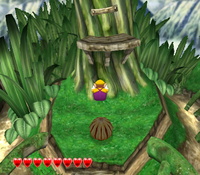Ground Pound
| It has been suggested that this page be split into the following: Ground Pound, Ground Pound Jump, Homing Ground Pound. (discuss) |
- This article is about the special move. For the minigame from Mario Party, see Ground Pound (minigame). For Donkey Kong's move that is also called "Ground Pound", see Hand Slap.
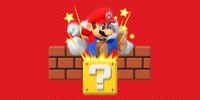
- “Yoshi will "Pound The Ground." This has many uses, and it rocks!”
- —Message Block, Super Mario World 2: Yoshi's Island
The Ground Pound, also known as the Hip Drop,[1] Pound the Ground attack, Bounce,[2] Butt-Bash,[3] Jump Smash,[4] Smash Attack,[5] and Butt Stomp (formatted as ground-pound in Super Mario 64 DS and the Super Mario Galaxy games; also formatted as ground pound[6] and also known as the Spin Jump in Paper Mario and Paper Mario: The Thousand-Year Door) is a move that has affected the Mario franchise dramatically, along with moves such as the Wall Jump and Spin Jump. The move is usually executed by crouching in midair, but it is sometimes used by pressing the jump button twice instead (usually in Mario Party minigames). When the move is used, the character will slam their rear end on the ground, which can cause many results.
The move can break or activate blocks from above, the opposite effect of a normal jump. It is sometimes the only way to defeat an enemy or complete a task, such as destroying Chain Chomps' stakes in the New Super Mario Bros. series, and is usually more powerful than a regular stomp. The Ground Pound is a common move that almost any character can use, even Boo, Dry Bones, Blooper, Birdo, and Bowser. Starting in Super Mario Galaxy, any objects or enemies that can be ground-pounded have a distinct emblem resembling an explosion.
History
Super Mario series
Super Mario Bros. 3
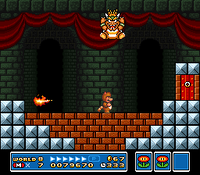
The move was first introduced in Super Mario Bros. 3 by Bowser. Unlike in later versions of the move (where the user always faces forwards), Bowser faces the screen when he ground-pounds. If Mario is not in Fire or Hammer form, he must trick Bowser into ground-pounding the brick floor in the same lateral position three times to make him fall through it, defeating him.
This move was what the Bowser Bomb, Bowser's down special move in the Super Smash Bros. series, was based on.
Super Mario Land 2: 6 Golden Coins
Wario uses a ground pound as one of his attacks in Super Mario Land 2: 6 Golden Coins. If Mario is on the ground, the attack will briefly stun him.
Super Mario 64 / Super Mario 64 DS
Super Mario 64 is the first game Mario can ground-pound in. This move is activated by pressing the crouch button while in midair. Ground-pounding does serve some functions in this game, such as activating Blue Coin Blocks, reducing damage taken from severe drops if used close to the ground (sometimes completely nullifying the damage), and defeating enemies. It can also be used to make a quick landing while flying with the Wing Cap. In addition, there is a creature called Dorrie in the Hazy Maze Cave, and pounding his back makes his head go down. That gives easier access to his head, and when on Dorrie's head, the player has easier control over the direction of Dorrie's movements.
Mario also uses this move in the course the Bob-omb Battlefield in the mission Behind Chain Chomp's Gate, where he must pound the stump holding the Chain Chomp's leash in place in order to free it and claim the Power Star. Later, Mario must pound two pillars in the basement to drain the moat and get access to Vanish Cap Under the Moat.
The Pound the Ground attack is used once again in Whomp's Fortress, where the player must pound the Whomp King's back once he slams onto the ground in a total of three times in order to defeat him.
In the DS remake, the Pound the Ground attack can be used when Mario uses the Power Flower to become Balloon Mario by using the crouch button to cancel the effect. Wario's Pound the Ground attack lets him smash objects with twice the strength of others, while Yoshi's lets him smash only stumps and Blue Coin Blocks.
Super Mario Sunshine
The use of the Ground Pound is greatly expanded in Super Mario Sunshine. One of its main uses involves using it to flip small circular Manhole covers that appear in both Delfino Plaza and Ricco Harbor. This allows Mario to access secret underground tunnels, which often have Blue Coins or 1-Up Mushrooms hidden within them.
The Ground Pound is also used as a means of collecting Shine Sprites. For example, Mario must ground-pound a small stone wheel located on top of the lighthouse in Delfino Plaza in order to release the Shine Sprite hidden there. However, a normal Ground Pound will not have any effect. He must therefore first use the Rocket Nozzle to blast himself into the air, and then do a Ground Pound. This will result in an extra powerful Ground Pound, which is strong enough to break the stone wheel apart.
This move is also used to defeat certain bosses. For example, in Down with Petey Piranha! and Petey Piranha Strikes Back, the player must ground-pound Petey Piranha's engorged belly after spraying water into his mouth three times to defeat him. In addition, it is also used in Episode 3 of Gelato Beach, Wiggler Ahoy! Full Steam Ahead!, when Mario must battle Wiggler. After spraying the Dune Buds, causing Wiggler to flip onto his back, Mario must ground-pound specific segments of his body three consecutive times in order to defeat him. It is also used in the level just before this episode, Mirror Madness! Tilt, Slam, Bam!, where the player must use it to fling the Plungelos off the large mirrors near the Shine Tower.
Finally, the Ground Pound plays a major role during the final boss battle with Bowser and Bowser Jr. in Corona Mountain. Mario must again use the Rocket Nozzle to blast himself into the air, and then ground-pound five separate ends of the large slime-filled hot tub Bowser is sitting in, eventually resulting in the entire hot tub tipping over and Bowser being defeated.
The Ground Pound can also be used to break apart large square watermelons (often found in secret levels) when they block the way or to pound large nails into the ground.
The Ground Pound can also be used to prevent Mario from taking a considerable amount of damage due to a fall from a great height if used shortly before he hits the ground.
New Super Mario Bros.
The Ground Pound makes several appearances in New Super Mario Bros. When the player presses down on the D-Pad when in midair, the player will perform a Ground Pound; this can be canceled out mid-ground pound by pressing up on the . Ground Pounds can be used to break bricks or repeatedly earn coins from Coin Blocks (by holding the down button on the Control Pad), but Small Mario cannot break them or earn the coins repeatedly (Mario must keep doing Ground Pounds instead of holding down). In this game, Mario or Luigi can hold the Ground Pound down for as long as the player wants. This never appeared in any game after this.
The Sledge Bro is able to use this move to stun Mario if the plumber fails to jump.
At the World 5 Castle, the player will fight Petey Piranha, who will perform an angled Ground Pound after flying in the air for a few seconds. Once Petey Piranha touches the ground, he will become dizzy and fall down, giving Mario or Luigi a chance to stomp him, unless the plumber is hit.
In addition, Ground Pounds deal double damage on enemies and bosses; for example, Ground Pounding Bowser Jr. would result in Mario/Luigi dealing two hits, rather than one from a single jump. They can immediately send Koopa Troopas in their shells and start sliding quickly, or to make Snailicorns slide across the ice.
If Mario is Mini Mario, then Ground Pounds are required to deal damage, but the damage would only be equal of a regular jump. Ground Pounds must be used as Mini Mario to defeat Mummipokey and Petey Piranha to go to Worlds 4 and 7, respectively (however, using certain cannons can also take Mario there).
Super Mario Galaxy
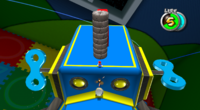
In Super Mario Galaxy, the Ground Pound is mainly used to activate Ground-Pound Switches, large switches emblazoned with the Ground Pound logo. These switches appear in almost every galaxy, and can perform any number of functions when pounded, from making Star Bits appear to causing an entire section of a wall to fall down.
In addition to this, beetle-like creatures called Mandibugs make their appearance in this game, and they have the Ground Pound symbol right on the back of their shell, indicating that Mario must defeat them using a Ground Pound. The boss Bugaboom fought later in the game is also defeated in a similar fashion, though he must be Ground Pounded three times.
The Ground Pound is also used to pound Stumps into the ground. An example of this is in the mission "The Dirty Tricks of Major Burrows" in the Gusty Garden Galaxy, where Mario must Ground Pound Stumps sticking out of three large apple-shaped planetoids in order to send the large caterpillar inside burrowing through to the next one.
Many Stone Wheels with the Ground Pound symbol on them also appear in this game, and are usually found stacked on top of one another. Mario must simply Ground Pound over the entire stack to obliterate them all. This is seen in the Toy Time Galaxy in the mission "Heavy Metal Mecha-Bowser," where Mario must Ground Pound the stack of Stone Wheels on the head of the Mecha-Bowser in order to defeat it.
Undergrunt Gunners are also defeated through the use of the Ground Pound, as the glass case covering the cockpit of their large cannons must be Ground Pounded three times in order to break it and defeat them.
There are orange Springboards in certain galaxies with the Ground Pound symbol on them. When the player Ground Pounds them, they will be flung into the air, allowing them to reach certain ? Blocks or platforms that they would not normally be able to reach.
Performing a Ground Pound while underwater instead has Mario briefly dive downwards.
Also, quickly after a spin in midair, Mario or Luigi can do a Homing Ground Pound, which will cause him to come crashing down directly on a nearby enemy or object without needing to aim first. This move is not mentioned in the game's instruction booklet.
New Super Mario Bros. Wii
The Ground Pound from New Super Mario Bros. Wii is almost the same as the Ground Pound from New Super Mario Bros.. Starting from this game, Ground Pounding a Koopa Troopa, Buzzy Beetle etc. does not make it retreat into its shell and start sliding, but defeats it instantly. However, the double damage effect was removed on bosses in this game, instead dealing only one hit, just like a normal jump.
It has also been shown that Roy Koopa and Morton Koopa Jr. can use this move in their battles.
In addition, this game introduces the Simultaneous Ground Pound which is only available in multiplayer.
Super Mario Galaxy 2
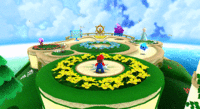
The Ground Pound can also be used in Super Mario Galaxy 2, and serves the same purpose as in its predecessor, though with a few minor differences. For example, meteorites with the Ground Pound symbol on them appear out of the ground in every Bowser level, which the player must Ground Pound in exactly the right place to send them flying into large stone locks blocking the way through the door to the next area.
Meteorites also appear during every Bowser battle, and therefore serve as the player's main means of dealing damage to Bowser in his giant form (however, many of them also release damaging shock waves when they hit the ground, so they are somewhat of a double-edged sword in this regard). The player must Ground Pound several of these meteorites into Bowser during the battle, hitting him a total of four times to defeat him (with the exception of the final battle, in which Bowser will return after being defeated and the player must Ground Pound four more planetoids into him), for a grand total of sixteen times over the course of all three Bowser battles in the game.
Both Glamdozer and her Pupdozer underlings also feature the Ground Pound symbol emblazoned in white (purple in Glamdozer's case) directly on their stomachs, which is positioned as such to clue the player in to their weakness, indicating that they must be Ground Pounded in order to be defeated. However, unlike the majority of other Mario enemies, these particular adversaries must always be Ground Pounded when they are positioned under a flipping cage, as Mario cannot access their weak spot otherwise.
Bugaboom reappears in this game in the Puzzle Plank Galaxy, and is defeated in the same way as in Super Mario Galaxy.
The Whomp King also makes a reappearance in this game in the Throwback Galaxy, and must be defeated in exactly the same way as in Super Mario 64 (by Ground Pounding his back three times when he slams to the ground).
Finally, the Ground Pound also plays a key role in the defeat of Bowser Jr.'s Boomsday Machine in Bowser Jr.'s Boom Bunker, as Mario must Ground Pound the glass case covering the cockpit of the machine (in much the same way as when he dealt with Undergrunt Gunners in the first game).
The Homing Ground Pound move can also be used in this game, and is activated in the same way: by spinning and Ground Pounding at the same time.
Super Mario 3D Land
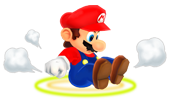
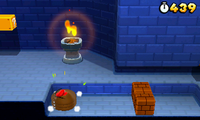
As in previous games, Mario can ground pound in Super Mario 3D Land, this time by pressing or
in mid-air. This allows Mario to hit/defeat enemies and destroy blocks and crates. Mario can also now use this move underwater as well (replacing the Super Mario Galaxy games' downward dive). If Mario uses a Statue Leaf to become Tanooki Mario, however, this move will be replaced by the form's statue transformation.
New Super Mario Bros. 2
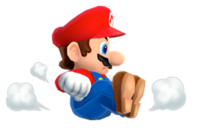
As in previous games, Mario can ground pound in New Super Mario Bros. 2, in the same way he could do it in New Super Mario Bros. and New Super Mario Bros. Wii.
New Super Mario Bros. U / New Super Luigi U / New Super Mario Bros. U Deluxe
The Ground Pound returns in New Super Mario Bros. U, New Super Luigi U and New Super Mario Bros. U Deluxe, working as it did in previous New Super Mario Bros. games.
Super Mario 3D World / Super Mario 3D World + Bowser's Fury
The Ground Pound returns in Super Mario 3D World, with similar properties to New Super Mario Bros. U and Super Mario 3D Land (although with a Lucky Bell being used to turn into Lucky Cat Mario, instead of a Statue Leaf), but it now also reveals invisible objects temporarily. Players can also perform a high jump after executing a Ground Pound, by pressing the jump button a bit after landing from the move (upon landing in the Switch port). This move is called a Ground Pound Jump[7]. The Simultaneous Ground Pound also returns.
If a character Ground Pounds another one under the effects of a Double Cherry, the Ground Pounded clone will become that of the Ground Pounder.
In the Bowser's Fury campaign in the Nintendo Switch port, the Ground Pound is an essential move to defeat Fury Bowser, but can only be done once he has his shell flipped over. Fury Bowser himself also uses a similar move which involves him tucking into his shell, jumping into the air and slamming his shell on the ground, creating a ring of fire. Additionally, the Ground-Pound Switch reappears in Bowser's Fury, which may reveal an obstacle course for Mario to cross or a battle arena full of enemies that must be defeated to obtain a Cat Shine.
Super Mario Odyssey
In Super Mario Odyssey, the Ground Pound and Ground Pound Jump return, working as they did in Super Mario 3D World, though the Ground Pound Jump can be done immediately after a Ground Pound. Pressing during the move's startup makes Mario do a dive instead, and doing so underwater makes Mario perform a Quick Swim forwards. The in-game brochure for the Lost Kingdom also implies that the starburst symbol used to denote areas vulnerable to a ground pound originated there.[8] Bowser uses this move after Mario and Cappy take away his hat from him, and when he does, he creates a ring of fire, although in some cases, it can be three.
Yoshi franchise
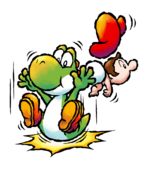
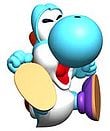
The Ground Pound (originally called Pounding The Ground or Pounding the Ground[9]) can also be used by Yoshi in the Yoshi games. It was first used in Super Mario World 2: Yoshi's Island. This move can be used to stomp on posts, break crates and defeat enemies. The Ground Pound has been referred to as "Yoshi's proudest move".[10] Baby Bowser also uses the Ground Pound in the first phase of his battle with Yoshi, and is capable of creating shockwaves that can hurt Yoshi and Baby Mario. The Bandit also uses this move in the Popping Balloons Mini Battle. This strategy can be used by Yoshi in return. The move returns in Yoshi's Story, Yoshi's Island DS, Yoshi's New Island and Yoshi's Crafted World. In Yoshi's Woolly World, Yoshi becomes a hammer when he ground pounds, except for when he is in his Mega Yoshi form.
The move Yoshi Bomb used by Yoshi in the Super Smash Bros. series was based on the Ground Pound Yoshi performs in the Yoshi series.
Mario Party series
The move appears in many Mario Party games, commonly to win minigames, activate panels, and flatten opponents, which stuns them for a few seconds. In Mario Party, Mario Party 2, and Mario Party 3, ground-pounding is performed by pressing ![]() and then
and then ![]() . In Mario Party and Mario Party 2, the move was called the Hip Drop. Since Mario Party 4, ground-pounding is performed by pressing the jump button while in the air.
. In Mario Party and Mario Party 2, the move was called the Hip Drop. Since Mario Party 4, ground-pounding is performed by pressing the jump button while in the air.
Wario franchise
Wario Land series
In Wario Land: Super Mario Land 3, Wario is able to do the move as Bull Wario. In Wario Land II and Wario Land 4, he can do this without any ability of any kind. In Wario Land 3, one of the various treasures that Wario collects will enable him to Ground Pound, while a second treasure makes it more powerful. If Wario performs this move from a great height, it becomes a block-breaking Super Smash Attack[5]. In Wario Land: Shake It!, Wario can perform a similar move called the Earthshake Punch.
In Virtual Boy Wario Land, Wario can Body Slam[11], which closely resembles a Ground Pound except Wario faces downwards and is a weaker maneuver. Bull Wario and King Dragon Wario can perform a more traditional Ground Pound.
Wario World
In Wario World, a Ground Pound can be performed by pressing the ![]() button while jumping. It has many uses, such as attacking enemies, destroying Rock Blocks, bouncing off Bunny Springs. It is also used to open trapdoors that lead to sub-levels where red diamonds can be found, as well as goal trapdoors that lead to boss battles. However, steel trapdoors cannot be opened with ordinary Ground Pound. Instead, Wario must use a Piledrive, which is executed the same way, but requires Wario to be holding an enemy or object beforehand.
button while jumping. It has many uses, such as attacking enemies, destroying Rock Blocks, bouncing off Bunny Springs. It is also used to open trapdoors that lead to sub-levels where red diamonds can be found, as well as goal trapdoors that lead to boss battles. However, steel trapdoors cannot be opened with ordinary Ground Pound. Instead, Wario must use a Piledrive, which is executed the same way, but requires Wario to be holding an enemy or object beforehand.
Donkey Kong 64
- See also: Simian Slam
In Donkey Kong 64, Donkey Kong's Simian Slam functions similarly to Mario's Ground Pound in Super Mario 64. It can be upgraded to Super Simian Slam, which allows the Kongs to activate blue Kong Switches, then it upgrades to Super Duper Simian Slam, which grants the Kongs the ability to slam red switches.
During the final battle against King Krusha K. Rool, he uses a ground pound attack during the first and fourth rounds.
Super Smash Bros. series
Bowser's Ground Pound move was later seen in Super Smash Bros. Melee, Super Smash Bros. Brawl, Super Smash Bros. for Nintendo 3DS / Wii U, and Super Smash Bros. Ultimate, known as the Bowser Bomb. Bowser either faces the screen or has his back to the screen when he uses his Ground Pound, similar to his Ground Pound in Super Mario Bros. 3.
Yoshi also comes with his own Ground Pound known as the Yoshi Bomb in the Super Smash Bros. series. Additionally, a standard Ground Pound appears in Super Smash Bros. for Nintendo 3DS / Wii U and Super Smash Bros. Ultimate as Luigi's new down throw, effectively replacing his body slam. Wario's down throw is also reminiscent of the Ground Pound from the Wario Land games. Princess Peach's down throw (from Super Smash Bros. Melee to Super Smash Bros. for Nintendo 3DS / Wii U) can be considered as a Ground Pound, since it involves her jumping in the air and slamming her opponents by sitting.
Paper Mario series
Paper Mario
The Spin Jump move in Paper Mario is extremely similar to a Ground Pound, and is first granted by the Super Boots found in Boo's Mansion. In the field, it allows Mario to break boarded-up holes, as well as to reveal the contents of hidden panels, which is required in order to obtain some of the collectible Star Pieces found in the game. Once Mario finds the Ultra Boots in the Toad Town Tunnels, he will lose the Super Boots and the Spin Jump ability will be replaced with the Tornado Jump.
Paper Mario: The Thousand-Year Door
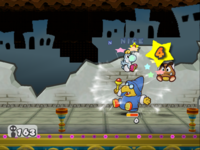
In Paper Mario: The Thousand-Year Door, after Mario finds the Super Boots in The Great Tree in Boggly Woods, he can do a Spin Jump by pressing ![]() in midair, which works like a Ground Pound (and referred to as a Ground Pound in the manual). The Spin Jump can be used in battle for 2 FP and does 4 base damage (two jumps that deal 2 damage each). When Bowser is playable in his Super Mario Bros.-style mini-stages, he can perform a Spin Jump the same way. Once Mario has obtained the Ultra Boots from the Riverside Station, he will lose the Super Boots, but retain the Spin Jump move while learning the new Spring Jump ability.
in midair, which works like a Ground Pound (and referred to as a Ground Pound in the manual). The Spin Jump can be used in battle for 2 FP and does 4 base damage (two jumps that deal 2 damage each). When Bowser is playable in his Super Mario Bros.-style mini-stages, he can perform a Spin Jump the same way. Once Mario has obtained the Ultra Boots from the Riverside Station, he will lose the Super Boots, but retain the Spin Jump move while learning the new Spring Jump ability.
Also, Yoshi has an attack called Ground Pound. The Action Command for this attack is to rapidly tap ![]() . The higher the gauge is filled, the more times the attack will hit, dealing 1 damage each hit. No FP is needed to use this attack, as it is an initial attack. Also, if his attack power is boosted first, it will act like a Power Bounce.
. The higher the gauge is filled, the more times the attack will hit, dealing 1 damage each hit. No FP is needed to use this attack, as it is an initial attack. Also, if his attack power is boosted first, it will act like a Power Bounce.
Super Paper Mario
In Super Paper Mario, a Pixl named Thudley grants the hero the Ground Pound ability. This move can be used to stomp on yellow posts, which activates certain things, and to deal double damage to enemies. Also, O'Chunks can perform ground pounds in his boss battles.
Mario + Rabbids Kingdom Battle
In Mario + Rabbids Kingdom Battle, Yoshi can perform a Ground Pound when landing from a Team Jump, causing a shockwave that harms all characters in the vicinity, whether they are Yoshi's teammates or enemies. It can also be used by Valkyries, Bwario, and the Lava Queen.
Profiles
Super Mario Sunshine
- Instruction booklet description: "Press
 in mid-jump to come crashing down onto enemies and crates, causing major damage."
in mid-jump to come crashing down onto enemies and crates, causing major damage."
- "NOTE! When falling from high places, try doing a Ground Pound right before landing."
Super Mario 3D Land
- North American website bio: "Send Mario down with extra force, and crush some poor Goomba's hopes and dreams."
- European website bio: "Press the L Button (or the R Button) in mid-air to perform a Ground Pound. A powered-up Mario can smash blocks and other objects using a Ground Pound."
New Super Mario Bros. 2
- European website bio: "To perform a powerful Ground Pound, press the down direction on the +Control Pad or Circle Pad while you're in mid-air. Boom!"
Super Mario Maker for Nintendo 3DS
- Electronic manual description: "
in midair"
Names in other languages
Ground Pound
| Language | Name | Meaning | Notes |
|---|---|---|---|
| Japanese | ヒップドロップ Hippu Doroppu ヒップアタック[12] Hippu Atakku |
Hip Drop Hip Attack |
|
| Chinese | 撞地[19][20][21][22] (iQue) Zhuàng Dì 臀部撞地 (Nintendo) Túnbù Zhuàng Dì |
Hit the ground Hip hit the ground |
|
| Dutch | Stampsprong[?] | Stomp jump | |
| German | Stampfattacke Freifall-Attacke[17] |
Stomp attack Freefall attack |
|
| Italian | Schianto a terra Salto a schianto Attacco frantumatutto[18] |
Ground slam Crushing jump All-Shattering attack |
|
| Korean | 엉덩이 찍기[?] Eongdeongi Jjikgi |
Butt Bashing | |
| Portuguese (NOA) | Pisada[?] | Stomp | |
| Portuguese (NOE) | Salto Bomba[?] | Bomb Jump | |
| Russian | Удар о землю[?] Udar o zemlyu |
Attack on the ground | |
| Spanish (NOA) | Salto Bomba Azotón Dar un pisotón Golpe Cadera (Paper Mario: The Thousand-Year Door Mini-Yoshi move)[?] |
Bomb Jump Pound To stomp Hip Strike |
|
| Spanish (NOE) | Salto Bomba Ataque destructor[13] |
Bomb Jump Destructive Attack |
Body Slam
| Language | Name | Meaning | Notes |
|---|---|---|---|
| Japanese | ボディプレス[23] Bodi Puresu |
Body Press |
Smash Attack
| Language | Name | Meaning | Notes |
|---|---|---|---|
| Japanese | ヒップアタック[24][25] Hippu Atakku |
Hip Attack | |
| Spanish | Ataque destructor[26] | Destructive Attack |
Super Smash Attack
| Language | Name | Meaning | Notes |
|---|---|---|---|
| Japanese | スーパーヒップアタック[25] Sūpā Hippu Atakku |
Super Hip Attack | |
| German | Super-Freifall-Attacke[17] | Super freefall attack | |
| Italian | super-attacco frantumatutto[18] | Super all-shattering attack | |
| Spanish | Súper ataque destructor[13] | Super destructive attack |
Spin Jump
| Language | Name | Meaning | Notes |
|---|---|---|---|
| Japanese | クルリンジャンプ[?] Kururin Janpu |
Spinning Jump | |
| Chinese | 旋转跳[27] Xuánzhuǎn Tiào |
Rotational Jump |
References
- ^ Nintendo Magazine System (AU) Issue #30, page 14.
- ^ Nintendo Magazine System (AU) Issue #42, page 18.
- ^ UK Nintendo Magazine #54 (March 1997), page 21.
- ^ Nintendo Power Volume 133, page 59.
- ^ a b Wario Land 4 American instruction booklet, page 10.
- ^ [1]
- ^ Tparris (October 12, 2017). Super Mario Odyssey - Action Guide. YouTube. Retrieved October 15, 2017.
- ^ Lost Kingdom article
- ^ Prima Bath. Nintendo 64 Game Secrets, 1999 Edition Prima's Official Strategy Guide. Page 100. "Some of the Shy Guys roaming around carry those treasured melons. You can snatch the fruit right out of their hands with Yoshi’s agile tongue or dispose of the Shy Guys first. Before gobbling them up or eliminating them with an egg toss, remember to Pound the Ground and change them to Yoshi’s favorite color to maximize your score."
- ^ Yoshi's Story instruction booklet, page 11.
- ^ Virtual Boy Wario Land English instruction booklet, page 21.
- ^ Wario Land Shake Japanese instruction booklet, pages 19, 24 and 25.
- ^ a b Wario Land 4 European instruction booklet, page 87.
- ^ Super Mario Galaxy instruction booklet, French segment
- ^ Super Mario Galaxy 2 move pamphlet, French side
- ^ a b Wario Land 4 European instruction booklet, page 47.
- ^ a b Wario Land 4 European instruction booklet, page 27.
- ^ a b Wario Land 4 European instruction booklet, page 107.
- ^ Official Chinese website for Yoshi's Island: Super Mario Advance 3 and Metroid Fusion. Retrieved March 1, 2020.
- ^ Official Chinese website for Super Mario 64 DS. Retrieved March 1, 2020.
- ^ Official Chinese website for New Super Mario Bros.. Retrieved March 1, 2020.
- ^ Online simplified Chinese manual for Super Mario 3D Land. Retrieved March 1, 2020.
- ^ Virtual Boy Wario Land: Awazon no Hihō Japanese instruction booklet, page 17.
- ^ Wario Land 3: Fushigi na Orgel Japanese instruction booklet, page 19.
- ^ a b Wario Land Advance: Yōki no Otakara Japanese instruction booklet, page 10.
- ^ Wario Land 4 3DS Ambassador Program electronic manual, page 3.
- ^ iQue's Paper Mario instruction booklet, page 30
Interwiki links
- Luftwaffe, Yoshi's move in Paper Mario: The Thousand-Year Door.
- Special moves
- Donkey Kong moves
- Donkey Kong Country Returns
- Donkey Kong Country: Tropical Freeze
- New Super Luigi U
- New Super Mario Bros.
- New Super Mario Bros. 2
- New Super Mario Bros. U
- New Super Mario Bros. Wii
- Paper Mario special moves
- Paper Mario: The Thousand-Year Door moves
- Super Mario 3D Land
- Super Mario 3D World
- Super Mario 64
- Super Mario Advance 4: Super Mario Bros. 3
- Super Mario Bros. 3
- Super Mario Galaxy
- Super Mario Galaxy 2
- Super Mario Odyssey
- Super Mario Sunshine
- Super Mario World 2: Yoshi's Island
- Super Paper Mario moves
- Super Smash Bros. Brawl
- Super Smash Bros. for Nintendo 3DS / Wii U
- Super Smash Bros. Melee
- Wario moves
- Wario Land 3
- Wario Land 4
- Wario Land II
- Wario Land: Super Mario Land 3
- Wario World
- Yoshi moves
- Yoshi's Crafted World
- Yoshi's Island DS
- Yoshi's Island: Super Mario Advance 3
- Yoshi's New Island
- Yoshi's Story
- Yoshi's Woolly World
